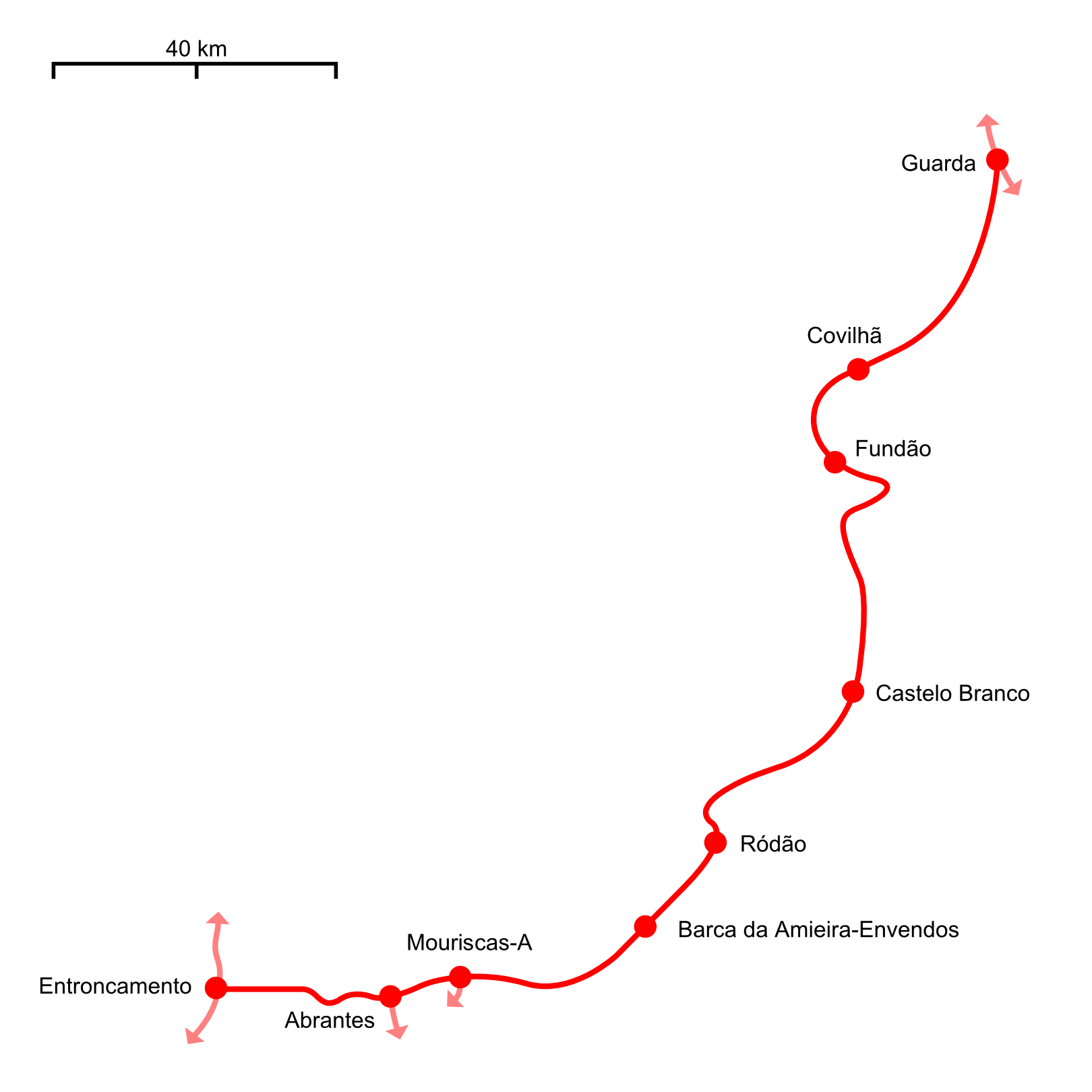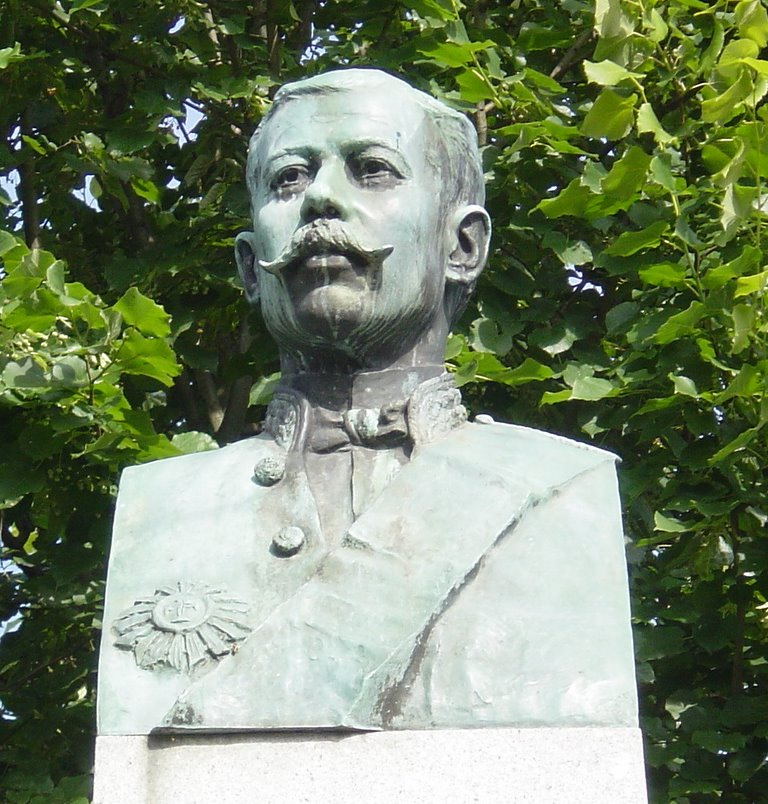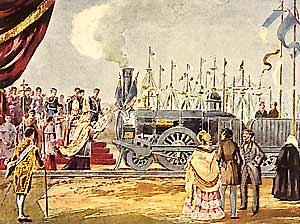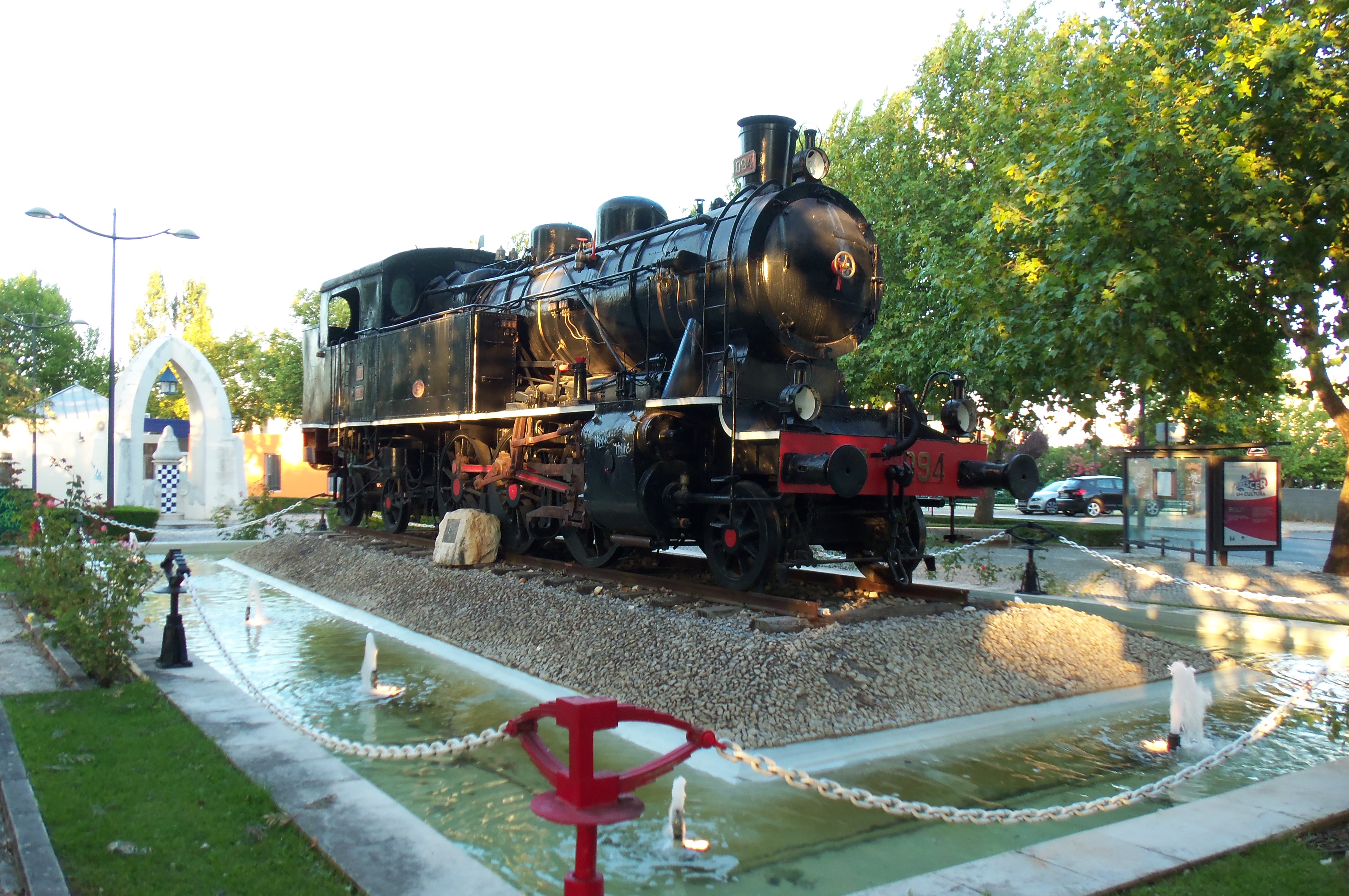|
Linha Da Beira Baixa
Linha da Beira Baixa, originally called Caminho de Ferro da Beira Baixa, is a railway line which connects the stations of Entroncamento and Guarda in central Portugal. The first section, from Abrantes to Covilhã was opened on 6 September 1891. The line to Guarda was opened on 11 May 1893. At the time, only the section from Abrantes to Guarda was considered to be part of Linha da Beira Baixa, while the route from Entroncamento to Abrantes belonged to the Linha do Leste Linha do Leste is a Portuguese railway line which connects Abrantes railway station to the border with Spain, near to Elvas. The connection to Spain was opened on 24 September 1863.Reis et al, 2006: 12 See also *List of railway lines in Po .... Passenger service on the Guarda-Covilhã segment reopened on 2 May 2021 after it fell into disuse in 2009. See also * List of railway lines in Portugal * List of Portuguese locomotives and railcars * History of rail transport in Portugal References ... [...More Info...] [...Related Items...] OR: [Wikipedia] [Google] [Baidu] |
Fundão, Portugal
Fundão () is a city and a municipality in the Castelo Branco District in Portugal. Fundão proper is an old city with 8,369 inhabitants in 2001, situated at the point where the slope of the Gardunha range meets the Cova da Beira plains, 500 metres above sea level. The municipality population in 2021 was 26,509. The area size is 700.20 km². The city of Covilhã is about 20 kilometers to the north by road. The municipality of Fundão is subdivided into 23 civil parishes known as ''freguesias'' in Portuguese. History During the Iron Age, from about 1000 B.C. until its destruction by the Romans, there was a Celtic Lusitanian Castro or fortified village in nearby São Brás Mount. The remains of a villa or agricultural manor house, workers houses and other associated buildings from the time of the Roman Empire have been found in the underground of the centre of the current city. This villa was rebuilt as a fortified medieval mansion during the High Middle Ages. The history of ... [...More Info...] [...Related Items...] OR: [Wikipedia] [Google] [Baidu] |
Centro Region, Portugal
The Central Region ( pt, Região do Centro, ) or Central Portugal is one of the NUTS statistical regions of Portugal, statistical regions of Portugal. The cities with major administrative status inside this region are Coimbra, Aveiro, Portugal, Aveiro, Viseu, Caldas da Rainha, Leiria, Castelo Branco, Portugal, Castelo Branco, Covilhã, Torres Vedras and Guarda, Portugal, Guarda. It is one of the seven Regions of Portugal (Nomenclature of Territorial Units for Statistics, NUTS II subdivisions). It is also one of the regions of Europe, as given by the European Union for statistical and Geography, geographical purposes. Its area totals . As of 2011, its population totalled 2,327,026 inhabitants, with a population density of 82 inhabitants per square kilometre. History Inhabited by the Lusitanians, an Proto-Indo-Europeans, Indo-European people living in the western Iberian Peninsula, the Roman Republic, Romans settled in the region and colonized it as a part of the Roman Province of ... [...More Info...] [...Related Items...] OR: [Wikipedia] [Google] [Baidu] |
Railway Lines Opened In 1891
Rail transport (also known as train transport) is a means of transport that transfers passengers and goods on wheeled vehicles running on rails, which are incorporated in tracks. In contrast to road transport, where the vehicles run on a prepared flat surface, rail vehicles (rolling stock) are directionally guided by the tracks on which they run. Tracks usually consist of steel rails, installed on sleepers (ties) set in ballast, on which the rolling stock, usually fitted with metal wheels, moves. Other variations are also possible, such as "slab track", in which the rails are fastened to a concrete foundation resting on a prepared subsurface. Rolling stock in a rail transport system generally encounters lower frictional resistance than rubber-tyred road vehicles, so passenger and freight cars (carriages and wagons) can be coupled into longer trains. The operation is carried out by a railway company, providing transport between train stations or freight customer facili ... [...More Info...] [...Related Items...] OR: [Wikipedia] [Google] [Baidu] |
History Of Rail Transport In Portugal
The history of rail transport in Portugal dates from 28 October 1856, when Portugal's first railway line was opened between Lisbon and Carregado: the ''Companhia dos Caminhos de Ferro Portugueses''. The network was gradually expanded both south of the Tagus and to the north of the country, as well as in the metropolitan areas of Lisbon and Oporto and to Spain. In 1887 the Douro railway line was completed; also in 1887 the ''Sud Express'' from Lisbon to France operated for the first time. In 1892 a law was passed creating the Board of Directors of the ''CF Estado'' (State Railways), but most railways remain in private ownership albeit with greater state regulation and requirement for co-operation. In 1910 the Portuguese monarchy was replaced by a republican constitution; there were also notable strikes by railway workers in 1910, 1911, 1912, 1914, 1918, 1919, 1920, 1922 and 1923. In 1926 the railway between Cascais and Lisbon was electrified at 1500 volts DC and the line's new L ... [...More Info...] [...Related Items...] OR: [Wikipedia] [Google] [Baidu] |
List Of Portuguese Locomotives And Railcars
This list provides an overview of the locomotives and railcars of the Portuguese railways, that is, the traction stock of earlier private railways, the state-owned ''Comboios de Portugal'' (CP) and its predecessor, the municipal '' Metropolitano Ligeiro de Mirandela'' and the two private transport companies ''Fertagus Fertagus is a commuter rail operator connecting Lisbon, Portugal's capital, to suburbs on the Setúbal Peninsula, located to the south across the Tagus River. Fertagus crosses the river over the Ponte 25 de Abril. Fertagus is owned by the Port ...'' and '' Takargo Rail''. Broad gauge steam locomotives Companhia Central e Peninsular dos Caminhos de Ferro em Portugal (CCeP) Originally 1440 mm gauge; taken over by the ''Companhia Real dos Caminhos de Ferro Portugueses'' in 1857; regauged to 1672 mm in 1860. South Eastern of Portugal Railway (SEPR) 1440 mm gauge Built by British investors; also known by its Portuguese name ''Companhia dos Cami ... [...More Info...] [...Related Items...] OR: [Wikipedia] [Google] [Baidu] |
List Of Railway Lines In Portugal
This is a list of railway lines in Portugal. List Sources * {{Railway lines in Portugal Portugal Lines Line most often refers to: * Line (geometry), object with zero thickness and curvature that stretches to infinity * Telephone line, a single-user circuit on a telephone communication system Line, lines, The Line, or LINE may also refer to: Arts ... * ... [...More Info...] [...Related Items...] OR: [Wikipedia] [Google] [Baidu] |
Linha Do Leste
Linha do Leste is a Portuguese railway line which connects Abrantes railway station to the border with Spain, near to Elvas. The connection to Spain was opened on 24 September 1863.Reis et al, 2006: 12 See also *List of railway lines in Portugal *List of Portuguese locomotives and railcars *History of rail transport in Portugal The history of rail transport in Portugal dates from 28 October 1856, when Portugal's first railway line was opened between Lisbon and Carregado: the ''Companhia dos Caminhos de Ferro Portugueses''. The network was gradually expanded both south ... References Sources * * Les Iberian gauge railways Railway lines opened in 1863 {{Europe-rail-transport-stub ... [...More Info...] [...Related Items...] OR: [Wikipedia] [Google] [Baidu] |
Covilhã Railway Station
Covilhã () is a city and a municipality in the Centro region, Portugal. The city proper had 34,772 inhabitants in 2001. The municipality population in 2011 was 51,797, in an area of . It is located in the Beiras e Serra da Estrela subregion and Beiras and Serra da Estrela Intermunicipal Community. The municipal holiday is October 20. Sometimes referred to as ''town of wool and snow'', Covilhã is one of the main urban centres of the historical Beira Interior region. The proximity of the mountains offers dramatic scenery and a great environment for those fond of hiking, camping, mountain climbing and skiing. With an industrial tradition historically focused on textile industry supplied by an abundance of wool produced in the area since antiquity, but with a more diversified industry in contemporaneity, Covilhã, which was once known as the " Portuguese Manchester", is also a university city nowadays awarding degrees from aeronautical engineering to medicine to philosophy. History ... [...More Info...] [...Related Items...] OR: [Wikipedia] [Google] [Baidu] |
Abrantes Railway Station
Abrantes Station is a railway station in Abrantes, Santarém, Portugal. History The station opened on 7 November 1862 and was inaugurated on 5 May 1863, connecting Abrantes and Crato. It was opened by (now defunct) Companhia Real dos Caminhos de Ferro Portugueses, later called Companhia dos Caminhos de Ferro Portugueses. On 18 March 1873, in order to connect Abrantes Station to Linha da Beira Baixa, plans were made by Joaquim J. de Almeida to connect Abrantes to Monfortinho, right next to the Spanish border. Similar plans were later made on 1 February 1879 by Lourenço de Carvalho (who was the Minister and Secretary of State for Business of Public Works, Commerce and Industry). It was later connected by Covilhã on 6 September 1891. It was mentioned by Hans Christian Andersen in his book ''A Visit to Portugal in 1866''. The Linha da Beira Baixa became a line to the Abrantes station at a later time than the Linha do Leste. Lines * Linha da Beira Baixa * Linha do Les ... [...More Info...] [...Related Items...] OR: [Wikipedia] [Google] [Baidu] |
Railway
Rail transport (also known as train transport) is a means of transport that transfers passengers and goods on wheeled vehicles running on rails, which are incorporated in tracks. In contrast to road transport, where the vehicles run on a prepared flat surface, rail vehicles (rolling stock) are directionally guided by the tracks on which they run. Tracks usually consist of steel rails, installed on sleepers (ties) set in ballast, on which the rolling stock, usually fitted with metal wheels, moves. Other variations are also possible, such as "slab track", in which the rails are fastened to a concrete foundation resting on a prepared subsurface. Rolling stock in a rail transport system generally encounters lower frictional resistance than rubber-tyred road vehicles, so passenger and freight cars (carriages and wagons) can be coupled into longer trains. The operation is carried out by a railway company, providing transport between train stations or freight customer facilit ... [...More Info...] [...Related Items...] OR: [Wikipedia] [Google] [Baidu] |
Entroncamento Railway Station
Entroncamento () is a Portuguese municipality in district of Santarém in the Médio Tejo Subregion (''Middle Tagus'') of the Centro Region. The population in 2011 was 20,206, in an area of 13.73 km². Situated in the Ribatejo, it benefits from its geo-strategic position along the Tagus Valley, with important accessibility to the motorways and railway-lines that historically proportioned its growth and expansion. History Entroncamento originated in the middle of the 19th century, with the birth of the national railway network, as a simple train-stop, from two small railway construction camps: Casal das Vaginhas and Casal das Gouveias. The majority of the early rail workers/settlers were foreign, coming from different countries throughout Europe, but eventually workers from Beira Baixa and Alentejo moved to the region. Its toponymic name ''Entroncamento'' literally mean ''junction'', owing to being the junction of the two railway lines that developed in 1864: the ''Linha ... [...More Info...] [...Related Items...] OR: [Wikipedia] [Google] [Baidu] |







